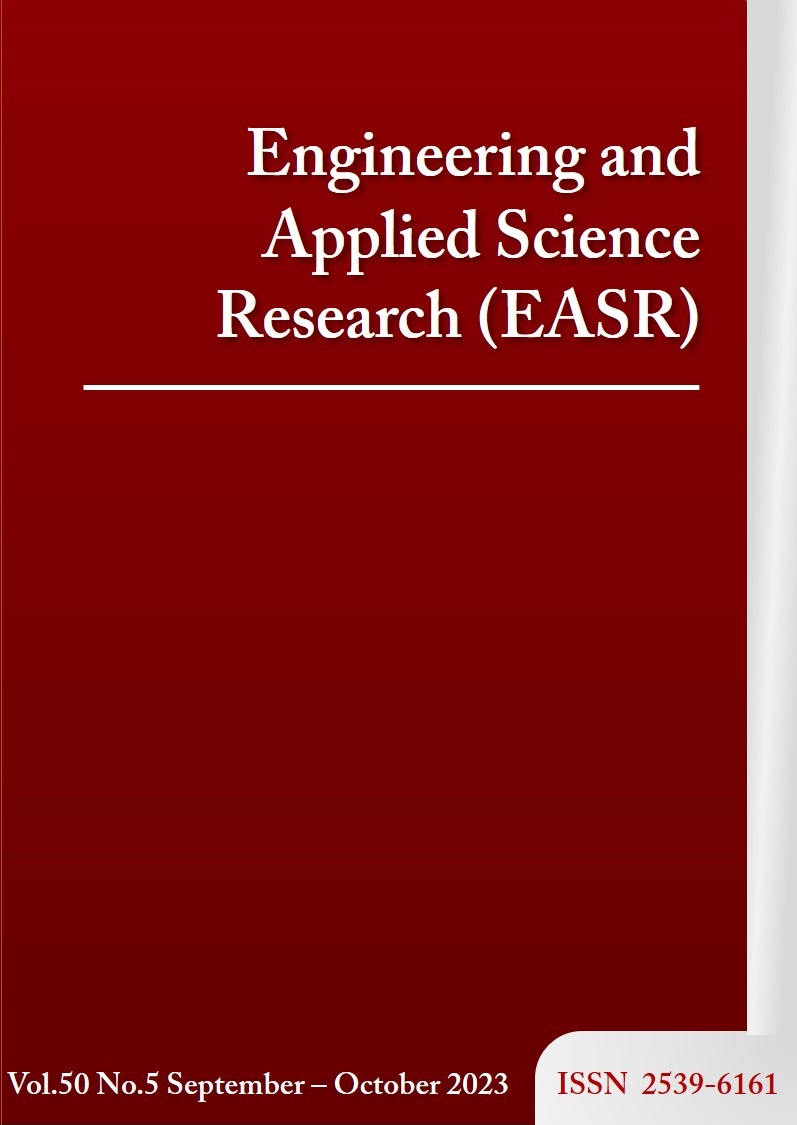Forecasting dam water inflows with fuzzy support vector regression using a rainy season-based membership function
Main Article Content
Abstract
Establishing proper management of dam water inflows is essential for successful planning and irrigation. This research aimed to forecast the water inflow into the Queen Sirikit Dam, located in Pha Leud Sub-district, Tha Pla District, Uttaradit Province, Thailand. The dam was constructed across the Nan River. The research proposes a new method that uses fuzzy support vector regression (FSVR) based on a generalized bell-shaped membership function that depends on the rainy season. Moreover, a comparison was made between this method and FSVR based on the linear function of time, which is commonly used, as well as classical support vector regression (SVR). The predictive ability of the models was evaluated using 10-fold cross-validation on 3,700 samples. The results indicate that FSVR based on a generalized bell-shaped membership function is more effective than the other two methods, with a mean absolute error (MAE) of 15.6247 m3/s and R-square (R2) of 0.7984. This shows an improvement over the linear membership function, which had an MAE of 17.2566 m3/s and an R2 of 0.7555. Meanwhile, the classical SVR model had an MAE of 23.6997 m3/s and an R2 of 0.6741. These findings suggest that FSVR based on a generalized bell-shaped membership function is an effective approach for forecasting dam water inflows. Consequently, it will be highly beneficial for the efficient management of the dam, including drainage or warning announcements to downstream populations.
Article Details

This work is licensed under a Creative Commons Attribution-NonCommercial-NoDerivatives 4.0 International License.
This work is licensed under a Creative Commons Attribution-NonCommercial-NoDerivatives 4.0 International License.
References
Than NH, Ly CD, Tat PV. The performance of classification and forecasting Dong Nai River water quality for sustainable water resources management using neural network techniques. J Hydrol. 2021;596:126099.
Kouadri S, Kateb S, Zegait R. Spatial and temporal model for WQI prediction based on back-propagation neural network, application on EL MERK region (Algerian southeast). J Saudi Soc Agric Sci. 2021;20(5):324-36.
Sun X, Zhou Z, Wang Y. Water resource carrying capacity and obstacle factors in the Yellow River basin based on the RBF neural network model. Environ Sci Pollut Res. 2023;30:22749-59.
Turhan E. A Comparative evaluation of the use of artificial neural networks for modeling the rainfall–runoff relationship in water resources management. J Ecol Eng. 2021;22(5):166-78.
Vapnik V, Golowich SE, Smola A. Support vector method for function approximation, regression estimation and signal processing. In: Mozer MC, Jordan M, Petsche T, editors. Advances in Neural Information Processing Systems. Cambridge: MIT Press; 1996. p. 281-7.
Ding Y, Song X, Zen Y. Forecasting financial condition of Chinese listed companies based on support vector machine. Expert Syst Appl. 2008;34(4):3081-9.
Mukherjee S, Osuna E, Girosi F. Nonlinear prediction of chaotic time series using support vector machines. In: Principe J, Gile L, Morgan N, Wilson E, editors. Neural Networks for Signal Processing VII Proceedings of the 1997 IEEE Signal Processing Society Workshop; 1997 Sep 24-26; Amelia Island, USA. USA: IEEE; 1997. p. 511-20.
Lin CF, Wang SD. Fuzzy support vector machines. IEEE Trans Neural Netw. 2002;13(2):464-71.
Cheng MY, Wibowo DK, Prayogo D, Roy AFV. Predicting productivity loss caused by change orders using the evolutionary fuzzy support vector machine inference model. J Civ Eng Manag. 2015;21(7):881-92.
Gu X, Ni T, Wang H. New fuzzy support vector machine for the class imbalance problem in medical datasets classification. Sci World J. 2014;2014:536434.
Rustam Z, Ariantari NPAA. Comparison between support vector machine and fuzzy Kernel C-Means as classifiers for intrusion detection system using chi-square feature selection. AIP Conf Proc. 2018;2023(1):020214.
Maldonado S, López J, Vairetti C. Time-weighted Fuzzy Support Vector Machines for classification in changing environments. Inf Sci. 2021;559:97-110.
Prabakaran G, Vaithiyanathan D, Ganesan M. FPGA based effective agriculture productivity prediction system using fuzzy support vector machine. Math Comput Simul. 2021;185:1-16.
Subianto, Suryono, Suseno JE. Backpropagation Neural Network Algorithm for Water Level Prediction. Int J Comput Appl. 2018;179(19):45-51.
Hosseini SM, Mahjouri N. Developing a fuzzy neural network-based support vector regression (FNN-SVR) for regionalizing nitrate concentration in groundwater. Environ Monit Assess. 2014;186:3685-99.
Karmiani D, Kazi R, Nambisan A, Shah A, Kamble V. Comparison of predictive algorithms: backpropagation, SVM, LSTM and Kalman filter for stock market. 2019 Amity International Conference on Artificial Intelligence (AICAI); 2019 Feb 4-6; Dubai, United Arab Emirates. USA: IEEE; 2019. p. 228-34.
Madhu B, Rahman MA, Mukherjee A, Islam MZ, Roy R, Ali LE. A comparative study of support vector machine and artificial neural network for option price prediction. J Comput Commun. 2021;9(5):78-91.
Najwa Mohd Rizal N, Hayder G, Mnzool M, Elnaim BME, Mohammed AOY, Khayyat MM. Comparison between Regression Models, Support Vector Machine (SVM), and Artificial Neural Network (ANN) in River Water Quality Prediction. Processes. 2022;10(8):1652.
Wiriyarattanakul S, Auephanwiriyakul S, Theera-Umpon N. Runoff forecasting using fuzzy support vector regression. 2008 International Symposium on Intelligent Signal Processing and Communications Systems; 2009 Feb 8-11; Bangkok, Thailand. USA: IEEE; 2009. p. 1-4.
Na MG, Yang HY, Lim DH. A soft-sensing model for feedwater flow rate using fuzzy support vector regression. Nucl Eng Technol. 2008;40(1):69-76.
Moosavi N, Bagheri M, Nabi-Bidhendi M, Heidari R. Fuzzy support vector regression for permeability estimation of petroleum reservoir using well logs. Acta Geophys. 2022;70:161-72.
Mercer J. Functions of positive and negative type, and their connection with the theory of integral equations. Proc Roy Soc London Ser A. 1908;83:69-70.
Bas E, Yolcu U, Egrioglu E. Intuitionistic fuzzy time series functions approach for time series forecasting. Granul Comput. 2021;6:619-29.
Castro JR, Sanchez MA, Gonzalez CI, Melin P, Castillo O. A new method for parameterization of general type-2 fuzzy sets. Fuzzy Inf Eng. 2018;10(1):31-57.
Runnawut S. Mathematical modeling for water level prediction in Sirikit dam. SNRU J Sci Technol. 2016;8(1):178-86.
Supratid S, Aribarg T, Supharatid S. An integration of stationary wavelet transform and nonlinear autoregressive neural network with exogenous input for baseline and future forecasting of reservoir inflow. Water Resour Manage. 2017;31(12):4023-43.



